
Accrington is a town in the Hyndburn borough of Lancashire, England. It lies about 4 miles (6 km) east of Blackburn, 6 miles (10 km) west of Burnley, 13 miles (21 km) east of Preston, 20 miles (32 km) north of Manchester and is situated on the culverted River Hyndburn. Commonly abbreviated by locals to "Accy", the town has a population of 35,456 according to the 2011 census.

Art Nouveau is an international style of art, architecture, and applied art, especially the decorative arts. It was often inspired by natural forms such as the sinuous curves of plants and flowers. Other characteristics of Art Nouveau were a sense of dynamism and movement, often given by asymmetry or whiplash lines, and the use of modern materials, particularly iron, glass, ceramics and later concrete, to create unusual forms and larger open spaces. It was popular between 1890 and 1910 during the Belle Époque period, and was a reaction against the academicism, eclecticism and historicism of 19th century architecture and decorative art.

An art museum or art gallery is a building or space for the display of art, usually from the museum's own collection. It might be in public or private ownership, be accessible to all, or have restrictions in place. Although primarily concerned with visual art, art museums are often used as a venue for other cultural exchanges and artistic activities, such as lectures, jewelry, performance arts, music concerts, or poetry readings. Art museums also frequently host themed temporary exhibitions, which often include items on loan from other collections.

Louis Comfort Tiffany was an American artist and designer who worked in the decorative arts and is best known for his work in stained glass. He is associated with the art nouveau and aesthetic art movements.

The Victoria and Albert Museum in London is the world's largest museum of applied arts, decorative arts and design, housing a permanent collection of over 2.27 million objects. It was founded in 1852 and named after Queen Victoria and Prince Albert.
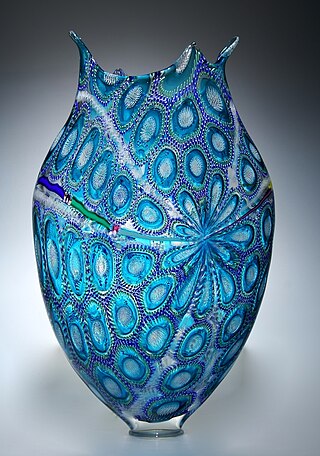
Studio glass is the modern use of glass as an artistic medium to produce sculptures or three-dimensional artworks. The glass objects created are intended to make a sculptural or decorative statement. Though usage varies, the term is properly restricted to glass made as art in small workshops, typically with the personal involvement of the artist who designed the piece. This is in contrast to art glass, made by craftsmen in factories, and glass art, covering the whole range of glass with artistic interest made throughout history. Both art glass and studio glass originate in the 19th century, and the terms compare with studio pottery and art pottery, but in glass the term "studio glass" is mostly used for work made in the period beginning in the 1960s with a major revival in interest in artistic glassmaking.

Walters Art Museum is a public art museum located in the Mount Vernon section of Baltimore, Maryland. Founded and opened in 1934, it holds collections from the mid-19th century that were amassed substantially by major American art and sculpture collectors, including William Thompson Walters and his son Henry Walters. William Walters began collecting when he moved to Paris as a nominal Confederate loyalist at the outbreak of the American Civil War in 1861, and Henry Walters refined the collection and made arrangements for the construction what ultimately was Walters Art Museum.
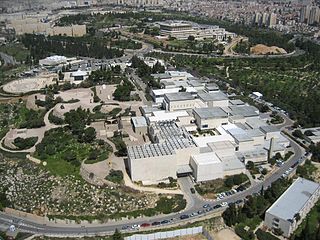
The Israel Museum is an art and archaeological museum in Jerusalem. It was established in 1965 as Israel's largest and foremost cultural institution, and one of the world's leading encyclopaedic museums. It is situated on a hill in the Givat Ram neighborhood of Jerusalem, adjacent to the Bible Lands Museum, the Knesset, the Israeli Supreme Court, and the Hebrew University of Jerusalem.

The Charles Hosmer Morse Museum of American Art, a museum noted for its art nouveau collection, houses the most comprehensive collection of the works of Louis Comfort Tiffany found anywhere, a major collection of American art pottery, and fine collections of late-19th- and early-20th-century American paintings, graphics and the decorative arts. It is located in Winter Park, Florida.

The Chicago Cultural Center, opened in 1897, is a Chicago Landmark building operated by Chicago's Department of Cultural Affairs and Special Events. The Cultural Center houses the city's official reception venue, where the Mayor of Chicago has welcomed presidents, royalty, diplomats, and community leaders. It is located in the Loop, across Michigan Avenue from Millennium Park.

The Capitoline Museums are a group of art and archaeological museums in Piazza del Campidoglio, on top of the Capitoline Hill in Rome, Italy. The historic seats of the museums are Palazzo dei Conservatori and Palazzo Nuovo, facing on the central trapezoidal piazza in a plan conceived by Michelangelo in 1536 and executed over a period of more than 400 years.
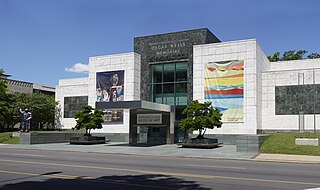
The Birmingham Museum of Art is a museum in Birmingham, Alabama. Its collection includes more than 24,000 paintings, sculptures, prints, drawings, and decorative arts representing various cultures, including Asian, European, American, African, Pre-Columbian, and Native American. The museum is also home to some Renaissance and Baroque paintings, sculptures,and decorative arts from the late 13th century to c. 1750.
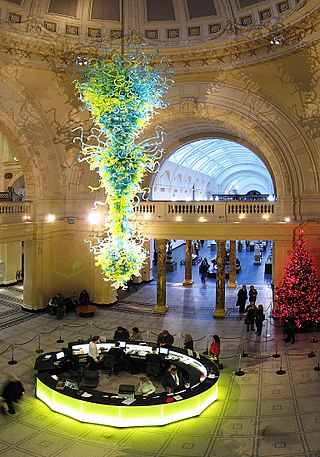
American craft is craft work produced by independent studio artists working with traditional craft materials and processes. Examples include wood, glass, clay (ceramics), textiles, and metal (metalworking). Studio craft works tend to either serve or allude to a functional or utilitarian purpose, although they are just as often handled and exhibited in ways similar to visual art objects.

The Columbia Museum of Art is an art museum in the American city of Columbia, South Carolina.

The Huntington Museum of Art is a nationally accredited art museum located in the Park Hills neighborhood above Ritter Park in Huntington, West Virginia. Housed on over 50 acres of land and occupying almost 60,000 square feet, it is the largest art museum in the state of West Virginia. The museum's campus is home to nature trails and the C. Fred Edwards Conservatory, a subtropical and tropical plant conservatory. The museum's collection includes American and European paintings, sculptures, prints, and drawings, as well as glass pieces manufactured in West Virginia and the Ohio Valley, American folk art, Chinese and Japanese decorative objects, Haitian art, firearms, and decorative arts from the Near East. In addition to its permanent collections, the museum hosts traveling exhibitions and houses the James D. Francis Art Research Library, the Grace Rardin Doherty Auditorium, and five art studios where artists in residence are periodically hosted and classes are held. The Huntington Museum of Art holds one of the largest collections of art in the state of West Virginia.
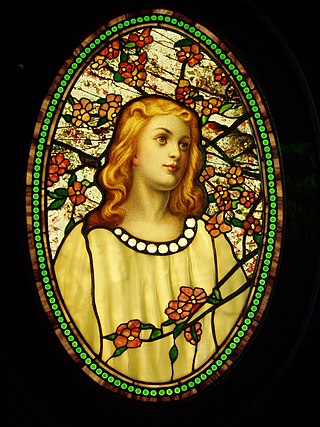
Tiffany glass refers to the many and varied types of glass developed and produced from 1878 to 1929-1930 at the Tiffany Studios in New York City, by Louis Comfort Tiffany and a team of other designers, including Clara Driscoll, Agnes F. Northrop, and Frederick Wilson.

The Museum of Art, Rhode Island School of Design is an art museum integrated with the Rhode Island School of Design, in Providence, Rhode Island, US. The museum was co-founded with the school in 1877. It is the 20th-largest art museum in the United States, and has seven curatorial departments.

Cameo glass is a luxury form of glass art produced by cameo glass engraving or etching and carving through fused layers of differently colored glass to produce designs, usually with white opaque glass figures and motifs on a dark-colored background. The technique is first seen in ancient Roman art of about 30 BC, where it was an alternative to the more luxurious engraved gem vessels in cameo style that used naturally layered semi-precious gemstones such as onyx and agate. Glass allowed consistent and predictable colored layers, even for round objects.
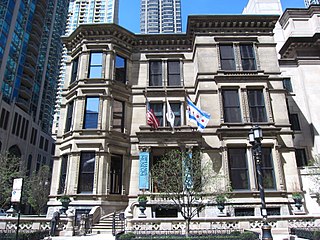
The Richard H. Driehaus Museum is a museum located at 40 East Erie Street on the Near North Side in Chicago, Illinois, near the Magnificent Mile. The museum is housed within the historic Samuel M. Nickerson House, the 1883 residence of a wealthy Chicago banker. Although the mansion has been restored, the Driehaus Museum does not re-create the Nickerson period but rather broadly interprets and displays the prevailing design, architecture, and decorating tastes of Gilded Age America and the art nouveau era in permanent and special exhibitions.

Pierre-Adrien Dalpayrat or Adrien Dalpayrat was a French potter who was a significant figure in French art pottery, especially known for his innovative coloured ceramic glazes, mostly on stoneware, but also earthenware and porcelain. After working for several makers of faience, mostly in the south, from 1889 he established his own studio in Bourg-la-Reine, not far from Paris, with his work on sale in various galleries in the capital and other cities.





















